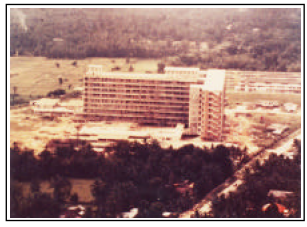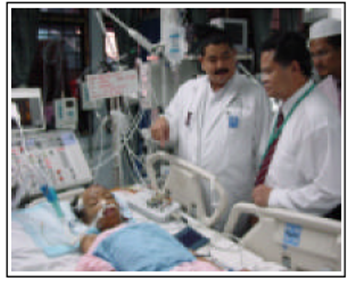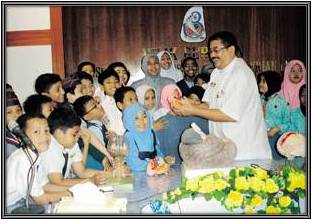The School of Medical Sciences of Universiti Sains Malaysia (USM), which is foundes in 1979, was the third medical school in Malaysia following the establishment of schools by Universiti Malaya and Universiti Kebangsaan Malaysia. The earliest facilities of USM’s medical school were located in Penang. Penang is an island separated from the mainland Peninsular Malaysia by the Straits of Malacca. Prior to construction of the bridge which connects Penang to the mainland, the main communication was by sea or air.

Due to an increase demand for doctors, the Malaysian government decided to increase the intake of medical students into these three universities. To achieve this, USM had to expand its resources by upgrading its facilities and acquiring more teaching staff. However, the USM’s main campus in Penang was and communications to the island were limited. In order to overcome this obstacle, land on mainland Peninsular Malaysia was sought to build the USM’s school of Medical Sciences and its teaching hospital. A piece of land in Kubang Kerian was chosen as the site for the medical school was to stimulate economic growth in the area by providing more jobs in the healthcare industry. The facilities were completed in 1983 after 5 years of construction. Following its completion, the medical school and its teaching hospital became the largest healthcare institution on the east coast of Peninsular Malaysia.It was the only medical school located in a small rural town and not in Kuala Lumpur, the site of other medical schools at that time.In the years following its establishment, patients with neurological conditions who needed special treatment had to travel about 700km to Kuala Lumpur to receive treatment, or physicians from there had to make occasional visits to Kubang Kerian to treat patients. As a teaching hospital in a remote location, it was necessary to establish an institution with all specialties available, including neurologist and neurosurgeons. It was also important that the hospital offered high quality patient care, and education for undergraduate and postgraduate students in medicine.
THE EARLY YEARS OF CLINICAL NEUROSCIENCES AT USM
Due of the shortage with expertise in either neurology or neurosurgery in Malaysia during the years following the opening of USM’s medical school, doctors from abroad from these specialties were employed. These doctors contributed significantly to teaching undergraduate and postgraduate in USM in neurology and neurosurgery as well as providing clinical care to patients with neurological problems. The clinical held began after the arrival of Dr.Chandrasekar Bhallachandra Khare from India in 1989. Initially, he worked in Penang General Hospital and moved to USM upon its completion in 1983. Although Dr Khare was trained as a psychiatrist, he also took care of the patients with neurological conditions.In 1983, Dr. Khare was joined by Dr.Pratap Chand who was a general physician with the interest in neurology. Both doctors contributed to teaching clinical neurosciences to undergraduates and local doctors working at USM. Dr Khare left USM in 1988 and Dr Chand worked until 1989. Dr Maung Nyunt Win from Myanmar joined USM for 10 years feom 1990 until 2000. During his service, a number of local doctors working at USM trained in neurology as their postgraduate training in medicine. These doctors eventually joined Dr Maung Nyunt Win to provide neurology services at USM. They were Dr. Hanafiah Abdul Ghafoor (1993-1995), Dr. Mohd Riduan Abdullah (1994-1998) and Dr. Zakaria Abd Kadir (1995-1999), Dr. Anup Kumar Thaker, a neurologist from India, served USM as a visiting lecturer in medicine for 1 year from 1997-1998.
Currently, there are two neurologist serving USM. They are Dr. John Tharakan and Dr. Atul Prasad. Both joined USM IN 2002. Dr Ahmad Munawwir Husin, a clinical specialist, joined Dr. Tharakan and Dr. Prasad to expand the neurology services at USM. They are actively involved in research in epilepsy, stroke, migraine and movement disorders. Peadiatric neurology services are provided by Professor Zabidi Azhar Husin and Dr. Salmi Abdul Razak. As with neurologist, most of the neurosurgeons who initially worked at USM were from abroad. Dr. Fauzi Ahmad Ali Salem from Egypt became the 1st neurosurgeon to join USM in 1984. Most of his workload was in management of patients with head trauma who required urgent neurosurgical interventions.
Most of the elective neurosurgical cases were sent to General Hospital Kuala Lumpur for further management as the neurosurgical facility in USM in those years was still rudimentary. Dr. Salem left USM in 1987. For 3 years there was no neurosurgeon at USM until Dr. Benedict Marius Selladurai from Sri Lanka was employed by USM in 1990. Due to an increase in neurosurgical cases at USM, Dr. Shanmugan Chandasekaran joined Dr. Selladurai in 1992. However, Dr. Selladurai left USM to join Universiti Kebangsaan Malaysia in 1993. Following that, Dr. Chandrasekaran continued to provide neurosurgical services at USM until 1996.
In 1998, Dr Jafri Malin Abdullah, a Universiti Sains Malaysia graduate, became the 1st neurosurgeon to serve at USM. He received his training in neurosurgery at the University of Ghent, Belgium under Professor Luc Calliauw and Professor Jacques Caemart. Following his return, he decides to establish training programs in basic and clinical neurosciences, Dr George Jain joined Dr.Jafri Malin Abdullah in 2002 and 2 years later, Dr. Prakash Rao joined USM to expand the neurosurgical the neurosurgical service. Professor Luc Calliauw was appointed as the visiting professor to the department. His invaluable experience as the past president of the European Association of Neurological Surgeons (EANS) has provided extensive guidance to the young trainees in neurosurgery. The department also received Dr. Raj Kumar and Dr. Hillol Pal from India in 2005 to serve as visiting lectures. The vast knowledge and experience gained from these two individuals as a result of their different training backgrounds has contributed to further development in neurosurgical training in Malaysia.
A PLATFORM FOR CONSOLIDATION OF NEUROSCIENCES

The Department of Neurosciences at USM was initially established as a under the Department of Surgery on 17 August 2000. The unit was growing and so was separated from the Department of Surgery in order to fulfill its clinical and academic goals. The idea for the establishment of the department originated from Professor Mohd Roslani Abdul Majid, the first dean in School of Medical Sciences. Dr. Jafri Malin Abdullah became the first Head of Department and later was made a professor. Appointment of Dr. Jafri Malin Abdullah marked a new era in neurosciences at USM. Besides, being a state of the art centre of neurosurgical conditions, the Department also played an important role in providing a centre for postgraduate training in neurosciences and as a research hub for fundamental and clinical neurosciences.
Following the establishment of the Department, facilities in the USM’s teaching hospital catering for patients with neurological conditions underwent major refurbishment to ensure the standard of patient care met international standards. The neurointensive unit with its annexed high-dependency unit is equipped with numerous state-of-the-art machines and monitors to incorporate multimodality mini-laboratory for analyses of microdialysates and brain oxygen content in addition to basic operating microscopes, neuroendoscopic equipment, monitors for intraoperative neurophysiology and image guided neuronavigation system. With these in place, neurosurgery at USM is making a leap from mere trauma procedures during the previous decades, into functional, vascular and microneurosurgical procedures in the millennium. The neurophysiology laboratory is equipped for electroencephalography, electromyography, and nerve conduction studies and evoked potentials. In addition to facilitating the diagnosis of many neurological conditions, this equipment contributes to extensive research in neurosciences.
COMMUNITY SERVICES
The Department of Neurosciences of the School of Medical Sciences had always been the precursor in making this vision a reality by concerted efforts to make a difference every day in improving the understanding of the brain in health and disease for the local community, and beyond. Together with other USM inspiring neuroscience ventures such as the Brain Mind Nexus and numerous research centres/teams, we are committed to provide for this one nation, Malaysia, an effective public education and awareness about the brain and the nervous system, and how it influences our lives, health, and social interactions. Thus aptly, we propose this public engagement project, entitled “Brain Research and Awareness: 1Nation”, or simply, “B.R.A.1.N”.


